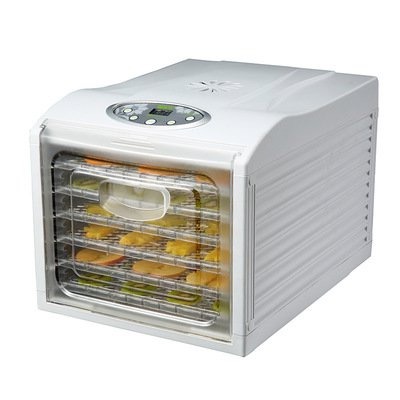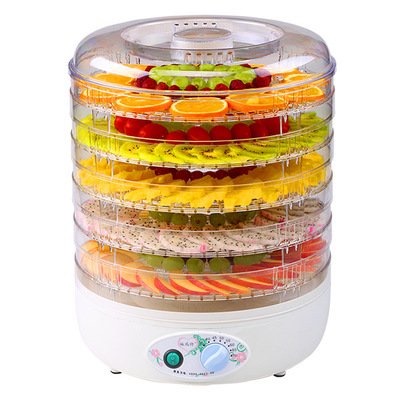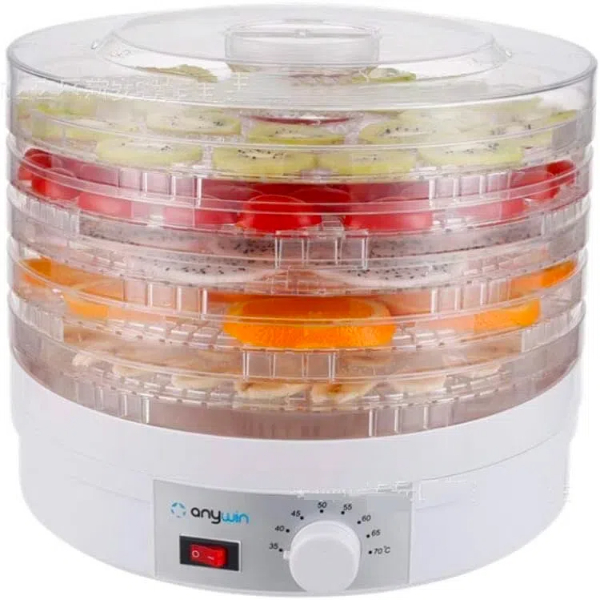
Content Menu
● Introduction to Fruit Home Dryer Machines
● Understanding the Fruit Home Dryer Machine
>> Key Components of a Fruit Home Dryer Machine
● Benefits of Using a Fruit Home Dryer Machine
>> 1. Preserves Nutrients
>> 2. Extends Shelf Life
>> 3. Saves Money
>> 4. Versatility
>> 5. Control Over Ingredients
● How to Use a Fruit Home Dryer Machine
>> 1. Prepare Your Fruits
>> 2. Pretreat (Optional)
>> 3. Arrange on Trays
>> 4. Set Temperature and Time
>> 5. Start the Drying Process
>> 6. Check for Doneness
>> 7. Cool and Store
● Popular Fruits for Drying
● Beyond Fruits: Other Uses for Your Home Dryer Machine
>> 1. Vegetable Dehydration
>> 2. Jerky Making
>> 3. Fruit Leather
>> 4. Dried Flowers and Crafts
● Choosing the Right Fruit Home Dryer Machine
● Maintenance and Care of Your Fruit Home Dryer Machine
● Conclusion
● Frequently Asked Questions
>> 1. What is the ideal temperature for drying fruits in a home dryer machine?
>> 2. How long does it take to dry fruits in a home dryer machine?
>> 3. Can I dry different types of fruits together in my home dryer machine?
>> 4. How do I know when my fruits are properly dried?
>> 5. How long can I store dried fruits made in my home dryer machine?
Introduction to Fruit Home Dryer Machines
In recent years, the popularity of fruit home dryer machines has skyrocketed as more people discover the joys and benefits of food dehydration. These versatile appliances, also known as food dehydrator machines or fruit dryers, have become essential tools for health-conscious individuals, culinary enthusiasts, and those looking to reduce food waste. In this comprehensive guide, we'll explore the world of fruit home dryer machines, their benefits, how to use them effectively, and the wide range of delicious creations you can make with these innovative devices.
Understanding the Fruit Home Dryer Machine
A fruit home dryer machine, also referred to as a food dehydrator or electric fruit dryer, is a kitchen appliance designed to remove moisture from fruits, vegetables, and other foods. By circulating warm air around the food items, these machines slowly evaporate the water content, resulting in dried, shelf-stable products. The process of dehydration not only extends the shelf life of fruits and vegetables but also concentrates their flavors and nutrients.
Key Components of a Fruit Home Dryer Machine
1. Trays: Most fruit home dryer machines come with multiple trays, allowing you to dry various foods simultaneously. These trays are typically made of food-grade plastic or stainless steel and are designed to promote even air circulation.
2. Heating element: The heating element generates warm air, which is crucial for the dehydration process. Quality fruit dryers offer adjustable temperature controls to accommodate different types of foods.
3. Fan: A built-in fan helps circulate the warm air evenly throughout the machine, ensuring consistent drying across all trays.
4. Timer: Many modern fruit home dryer machines feature digital timers, allowing you to set precise drying times for your foods.
5. Temperature control: Adjustable temperature settings enable you to customize the drying process for different types of fruits and vegetables.

Benefits of Using a Fruit Home Dryer Machine
Investing in a fruit home dryer machine offers numerous advantages for both your health and your wallet. Let's explore some of the key benefits:
1. Preserves Nutrients
Unlike other preservation methods that may involve high heat or chemical additives, fruit drying techniques used in home dryer machines help retain most of the nutrients present in fresh fruits and vegetables. The low-temperature drying process preserves vitamins, minerals, and antioxidants, making dried fruits a nutritious snack option.
2. Extends Shelf Life
By removing moisture from fruits and vegetables, a fruit home dryer machine significantly extends their shelf life. Properly dried and stored fruits can last for several months to a year, reducing food waste and allowing you to enjoy your favorite fruits year-round.
3. Saves Money
While there is an initial investment in purchasing a fruit home dryer machine, it can save you money in the long run. You can buy fruits and vegetables in bulk when they're in season and on sale, then dehydrate them for future use. This approach is often more cost-effective than purchasing pre-packaged dried fruits from stores.
4. Versatility
A fruit home dryer machine isn't limited to just drying fruits. These versatile appliances can also be used as vegetable dehydrators, jerky dryers, and even for making homemade fruit leather. The possibilities are endless, allowing you to experiment with various recipes and create healthy snacks for the whole family.
5. Control Over Ingredients
When you use a fruit home dryer machine, you have complete control over the ingredients that go into your dried foods. This means you can avoid added sugars, preservatives, and artificial colors often found in store-bought dried fruits.
How to Use a Fruit Home Dryer Machine
Using a fruit home dryer machine is relatively simple, but there are some key steps to follow for the best results:
1. Prepare Your Fruits
Start by washing your fruits thoroughly and removing any blemishes or overripe spots. For most fruits, you'll want to slice them into uniform pieces to ensure even drying. Some fruits, like berries, can be dried whole.
2. Pretreat (Optional)
Some fruits benefit from pretreatment to prevent browning and enhance flavor. This can involve dipping sliced fruits in lemon juice or ascorbic acid solution before drying.
3. Arrange on Trays
Place the prepared fruit pieces on the dehydrator trays in a single layer, ensuring they don't overlap. This allows for proper air circulation and even drying.
4. Set Temperature and Time
Consult your fruit home dryer machine's manual for recommended temperature settings and drying times for different fruits. Generally, most fruits dry best at temperatures between 125°F and 135°F (52°C to 57°C).
5. Start the Drying Process
Turn on your fruit dryer and let it run for the recommended time. Depending on the fruit and your machine, this can take anywhere from 6 to 36 hours.
6. Check for Doneness
Periodically check your fruits for doneness. Properly dried fruits should be pliable but not sticky or moist. If needed, continue drying for additional time.
7. Cool and Store
Once your fruits are fully dried, allow them to cool completely before storing them in airtight containers or vacuum-sealed bags.

Popular Fruits for Drying
While you can dry almost any fruit in a home dryer machine, some fruits are particularly well-suited for dehydration:
1. Apples
2. Bananas
3. Strawberries
4. Mangoes
5. Pineapples
6. Peaches
7. Apricots
8. Grapes (to make raisins)
9. Cherries
10. Blueberries
Each of these fruits offers unique flavors and textures when dried, making them perfect for snacking, baking, or adding to trail mixes.
Beyond Fruits: Other Uses for Your Home Dryer Machine
While fruit drying is a primary function, your home dryer machine is capable of much more:
1. Vegetable Dehydration
Use your appliance as a vegetable dehydrator to create crispy vegetable chips, dried herbs, or ingredients for homemade soups and stews.
2. Jerky Making
Transform your fruit dryer into a jerky dryer by using it to make delicious, protein-packed beef, turkey, or even vegetarian jerky.
3. Fruit Leather
Create healthy, homemade fruit leather by pureeing fruits and spreading them thinly on dehydrator trays before drying.
4. Dried Flowers and Crafts
Explore your creative side by using your fruit home dryer machine to dry flowers for potpourri or craft projects.
Choosing the Right Fruit Home Dryer Machine
When selecting a fruit home dryer machine, consider the following factors:
1. Capacity: Choose a model with enough trays to meet your needs.
2. Temperature control: Look for machines with adjustable temperature settings for versatility.
3. Timer: A built-in timer can be very convenient, especially for longer drying sessions.
4. Noise level: Some machines are quieter than others, which can be important if you plan to run the dryer overnight.
5. Energy efficiency: Look for energy-efficient models to keep operating costs low.
6. Ease of cleaning: Dishwasher-safe trays and removable components make maintenance easier.
Maintenance and Care of Your Fruit Home Dryer Machine
To ensure your fruit home dryer machine continues to perform optimally, follow these maintenance tips:
1. Clean the trays and interior after each use with warm, soapy water.
2. Check and clean the air filters regularly to maintain proper airflow.
3. Inspect the heating element and fan periodically for any signs of wear or damage.
4. Store your machine in a clean, dry place when not in use.
5. Follow the manufacturer's instructions for any specific maintenance requirements.
Conclusion
A fruit home dryer machine is a valuable addition to any kitchen, offering a simple and effective way to preserve nature's bounty. Whether you're looking to create healthy snacks, reduce food waste, or explore new culinary possibilities, a food dehydrator machine opens up a world of opportunities. By understanding the basics of fruit drying techniques and exploring the versatility of your appliance, you'll be well on your way to enjoying delicious, nutritious dried fruits and so much more. Embrace the art of food dehydration and discover the countless ways a fruit home dryer machine can enhance your culinary adventures and promote a healthier lifestyle.

Frequently Asked Questions
1. What is the ideal temperature for drying fruits in a home dryer machine?
Answer: The ideal temperature for drying most fruits in a home dryer machine is between 125°F and 135°F (52°C to 57°C). However, some fruits may require slightly different temperatures, so it's best to consult your machine's manual or a reliable food dehydration guide for specific recommendations.
2. How long does it take to dry fruits in a home dryer machine?
Answer: The drying time can vary significantly depending on the type of fruit, its moisture content, and the thickness of the slices. On average, it can take anywhere from 6 to 36 hours to fully dry fruits. Berries and thinly sliced fruits tend to dry faster, while denser fruits like apples or pears may take longer.
3. Can I dry different types of fruits together in my home dryer machine?
Answer: While it's possible to dry different types of fruits together, it's generally recommended to dry similar fruits with comparable drying times and moisture content together. This ensures more even drying and prevents flavors from mixing. If you do dry different fruits together, make sure they require similar temperature settings.
4. How do I know when my fruits are properly dried?
Answer: Properly dried fruits should be pliable and leathery but not sticky or moist. They should not feel cool to the touch, which would indicate remaining moisture. For most fruits, you should be able to bend a piece, and it should not stick to itself. If you're unsure, it's better to over-dry slightly than under-dry, as under-dried fruits can spoil quickly.
5. How long can I store dried fruits made in my home dryer machine?
Answer: When properly dried and stored in airtight containers in a cool, dark place, most dried fruits can last for 6 to 12 months. Some fruits, like raisins, can last even longer. However, it's best to check your dried fruits periodically for any signs of moisture or mold. Vacuum-sealing can further extend the shelf life of your dried fruits.












